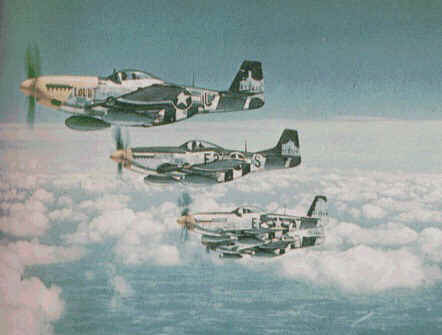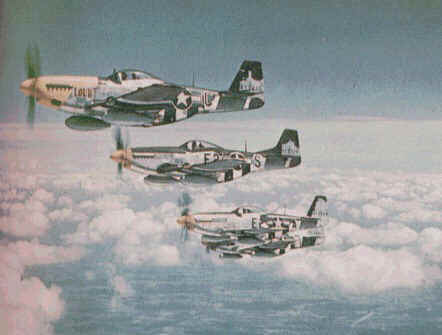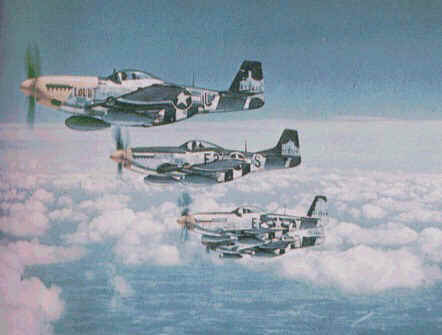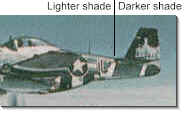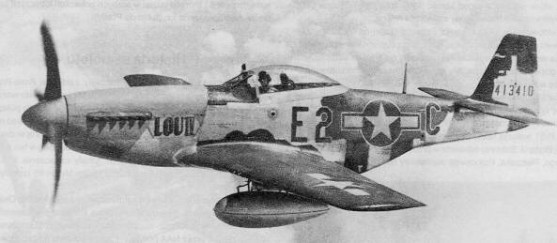by Martin Waligorski
The views of other people included below have been extracted from discussions about the subject of this article conducted on IPMS Stockholm’s pages and rec.models.scale newsgroup. All are copyright of their respective authors (Ed.)
This page might take a while to load. It contains a number of pictures that we wanted to reproduce at the highest practicable quality. The pictures will look best if your video card is configured to handle 16-bit color. Furthermore, you will need Netscape 3.0 or Internet Explorer 2.0 (or better) to view all text as intended.
Who the heck is LOU IV?
The purpose of World War colors in color gallery is to shed some light on the exciting issues of color camouflage of wartime aircraft. Although the few color photographs that remained from the period present a priceless value for a potential researcher, they may be just as tricky to interpret as black-and-white ones.
This article is all about a single aircraft – a P-51D Mustang nicknamed LOU IV, which served with US 8th Air Force’s 375th Fighter Squadron of the 361st Fighter Group, in England. It is about how much a picture can, or cannot, tell to the careful observer. How the research work, which most modellers get in contact with in one way or another, is conducted. How much we can, or cannot, be sure about.
These pages are meant to prompt discussion. And what a discussion it might be! Readers of this article will be undoubtedly amazed, as is the writer of these words, over the level and depth of historical knowledge possessed by some of our fellow modellers.
Enjoy!
The picture…
The argument…
Martin Waligorski: This is a very-well known photo of the P-51Ds, the first one bearing a nickname LOU IV. The photo is an evidence of how American fighter camouflage schemes in Europe sometimes evolved into non-standard flamboyant schemes. I noticed that some (actually quite much) confusion is present regarding the colors used on these Mustangs. Although a true color evidence as this picture provides is available, no-one seems to be quite sure whether the color that we see on the fighters’ top surfaces is green or blue.
Tom Gourlie: This is the caption for this photo from American Warplanes of World War II by AirTime Publishing: ”…Three of the aircraft, 44-13926, 13410, and 13568, are all Inglewood-built P-51D-5s, 13926 having the dorsal fin which was added to many P-51Ds built without it. Furthest away is P-51B-15 42-106811, with the original canopy. They flew with the Eighth Air Force’s 375th FS, 361st FG.”
Susanna Viljanen: LOU IV was the mount of Lt.Col Thomas Christian, the commanding officer of 361 FG, 8th AF. He didn’t score any aerial victories, but was shot down in this particular machine and killed in action in engagement with German fighters.
Bill Thys: I know this is kind of obvious, but regarding the paint scheme … the black and white stripes under the fuselage (and on the wings, though you can’t see them) were used only during and after the Normandy invasion. That should date the photo pretty well (to June or July 1944 – Ed.)
Dana Bell (through rec.models.scale): I know that this won’t be a final answer to an on-going argument, but I believe in the blue 361st FG P-51s. Every modeler will make his/her own choice on this, but here’s the evidence:
- British spotters. Most compelling is the fact that at least four wartime spotters, on separate occasions, independently recorded blue upper surface colors on 361st Mustangs. M.J.F. Bowyer was among the witnesses, and he has seen the other notebooks. While several vets have denied the use of blue, I consider it more likely that some would forget a color than those spotters would independently invent it.
- Color photos. I dealt with the surviving USAF color originals for over 20 years. I never felt that they showed a definite blue color, but they clearly showed some aircraft to be a different shade than the green which is clearly visible on other aircraft in the same shots. It is clear that if there’s a blue in those photos, it is not the same bright blue that appears on present-day restorations/warbirds.
- Use of blue by other units. There is an ongoing argument that it made no sense to use blue camouflage; yet there is no argument that the 56th FG used blue on some of its its P-47s. Remember, the main reason that paint was being added in June 44 was to cover the upper surface Invasion Stripes – nearly anything would do the job.
To my eye, it’s not a question of ”were they blue?” but which ones were blue, for how long were they blue, and which blue was used (probably Roundel Blue).
Martin Waligorski: Very interesting comment! The photograph shows  an upper camo color which is definitely bluish in tinge, maybe grey-blue or green-blue, and distinctively lighter than the insignia blue on star-and-bar. My 2cent’s worth guess from just looking at the photo could be British Roundel Blue, which had a tendency to weather into some deep indigo blue.
an upper camo color which is definitely bluish in tinge, maybe grey-blue or green-blue, and distinctively lighter than the insignia blue on star-and-bar. My 2cent’s worth guess from just looking at the photo could be British Roundel Blue, which had a tendency to weather into some deep indigo blue.
Dave Pride (through rec.models.scale): I’ve got to add my two cents worth. The LOU IV color photos I’ve seen, and all other aircraft from the 361st, have green camo not blue. These are color photos from the period and not someone’s recollection. I also find it interesting that the memory of the men who served in the 361st is discounted out of hand while some British spotter’s account is taken as fact.
Bill Shuey (through rec.models.scale): For whatever it’s worth – This blue vs. green issue comes up from time to time. Somewhere on the cover of an old magazine I have seen the picture of those 4 Mustangs and they are blue! But! You gotta remember that old fashioned color printing was a tricky process requiring use of stacked color filters to correct the negative to print process. Screw up the filters and you could get some very strange results. Use the wrong filter between negative and print paper and green becomes blue.
Remember the U.S.Navy 3 color scheme introduced in 1943?? Dark Sea Blue, Intermediate Blue and White? Sometime in late 1943 or 1944 someone sent a photo of some land-based Marine Hellcats on some Pacific Island to , I think it was Collier’s Magazine. The lab people doing the printing were about as educated on U.S. Aircraft color schemes as the average citizen is today and someone told them aircraft were camouflaged green. You guessed it! When the magazine came out that’s the way the lab man had corrected the negative. For some years there were those who swore that the U.S. Marines used a three tone scheme consisting of dark green, light green and white on land-based Hellcats in the Pacific. And don’t bother them with what some Marine veteran said-they’d seen it in the magazine! I gotta admit-it would make a sexy camouflage on a Hellcat or Corsair…
Jeff Gable (through rec.models.scale): Yes, I agree with this assessment. I have a couple of reference books from the 70’s and a couple of magazines also that have the famous photo of 4 of the 361st P-51s in formation, and the color is plainly blue. I also have one or two more recent books, printed after the ”blue vs.camo” argument was purportedly resolved in favor of camo, with that same exact photo, but now the topside color is plainly Olive Drab. There were no changes in any of the other colors, though. I always wondered how that happened… 🙂
Frank Tauss (through rec.models.scale): I looked at the 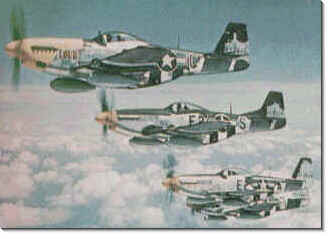 picture and this is my 2 cent’s worth: the top plane seems blue but the third plane seems Olive Drab to me and I’m not sure of other.
picture and this is my 2 cent’s worth: the top plane seems blue but the third plane seems Olive Drab to me and I’m not sure of other.
Question: Is it possible that these are rear anti-glare panels as opposed to squadron markings? I think that unless you know something of the film/filters used here I really don’t think something definitive can be said. The blue sky is so intense that I wonder if it’s right, I think it should be lighter at altitude.
Martin Waligorski: Funny that browsing yesterday through a book American Aircraft of the WW2, I found the very same picture, but on it it is pretty apparent that the first aircraft is dark green rather than blue.
I believe that, no matter how the actual colors where, the original photograph had been taken at high altitude with a lot of ultra-violet light present, which (known effect in photography on altitude, i.e. mountains, aircraft) resulted in over-presence of blue color in the picture.
That makes the puzzle only more complicated…
Ron ”Ackermann” (through rec.models.scale): I think that there is one point to make here and that is that the planes of 361st were not camouflaged in medium blue as we see on a lot of the rebuilds at airshows around the country. Bob Pond’s Planes of Fame East contains E2*S in medium blue as is LOU IV and Paul I, etc. Models painted in this color would be accurate for those planes. But, Steve Gotts, an Eighth Air Force historian from Cambridge, England wrote to a friend of mine( the secretary for the Mighty Eighth Historical Society here in the Midwest) that Olive Drab was not available at the time the order came down to apply top camo.He said ground crews used British deep green or insignia blue. (I am pretty sure I read that same bit of info in ”Color and Camouflage” in FSM (Fine Scale Modeler magazine – Ed.) a few years ago or so). The famous four plane photos clearly show that the top color of these planes is not the blue we are used to seeing at airshows.
Dana Bell again (through rec.models.scale): Last week, on a separate thread, another RMSer (member of rec.models.scale newsgroup – Ed.) mentioned how much he liked the blue P-51scheme. In subsequent postings other group members seemed to discount the existence of such a scheme. Rather than directly contradict these posters, I started a separate thread to present the evidence I’ve collected in the last thirty years.
There was no attempt to put a spin on history or compel anyone to accept blue P-51s as fact, only an attempt to show the possibilities. Neither was there an attempt to question memories of veterans. When I interviewed Ira Eaker several years ago he told me that no American unit flew Mosquitos in the MTO and that he didn’t want the aircraft. Would I have insulted him by writing a history of the 416th NFS and there Mosquito NF30s?
Five years ago I spent two weeks deployed with the 906th FG. I asked every member I could find – from the CO to the line maintenance folks – why their aircraft wore a non-standard camouflage scheme. They assured me that I was looking at the standard USAF camouflage for all F-16s – and we were standing right next to the aircraft. Years from now when I write about the two-color camouflage of 36270 and 36118 (no use of 36375) those vets may still disagree. They simply didn’t notice.
As for the British spotters’ (not spotter’s) reports, those old guys were young men who were interested in aircraft. They took notes, recording serial numbers and call letters. On separate occasions, four of them independently observed and recorded the same phenomenon: Blue P-51s of the 361st FG. Now July of 1944 was a busy time, and it would be an unusual pilot who stopped to take note of the color of every aircraft in his group. The first vet memories stating that all aircraft were Olive Drab appeared in 1980 – 36 years after the fact. It isn’t an insult to note that the spotters had the better documentation.
As for color photos, let’s look at the famous flight-of-four photos led by LOU IV. But remember that you are looking at the copy or copies. If the copies are published in magazines, they are not to be trusted for the reasons posted elsewhere. But photo dupes are also subject to massive color shifts. The first duplicate slide I ordered of USAF image K2487 showed that all aircraft were blue; years later my second copy showed that all were green.
But when you look at the originals, as I did on many occasions between 1976 and this January, you see that there are different paints on each of those aircraft. The original trannies are now at the National Archives, numbered K2487, K2488, and K2489.
From my notes on the originals, I see the four aircraft like this:
- E2*S: Clearly painted a flat Olive Drab or close substitute.
 This is the aircraft flown by Urben Drew, one of the vets claiming that all unit aircraft were similarly painted.
This is the aircraft flown by Urben Drew, one of the vets claiming that all unit aircraft were similarly painted. - E2*A: Sky Bouncer has a very glossy finish, and is darker than E2*S. There isn’t enough of the camouflage visible to definitively state what the color was.

- E2*H: Suzy G appears to use a flat paint, but again the color isn’t certain. Interestingly, this is one of the aircraft that the spotters recorded as blue.
- E2*C: LOU IV has a semi-gloss finish which is also showing a darker color
 than E2*S; I believe this is Roundel Blue, though some think Olive Drab or Insignia Blue. Sadly, this aircraft was the subject of a 3/4 front portrait taken from slightly above; I say sadly because the original was stolen before I began working with the collection in 1976. What has survived is contrasty and magenta.
than E2*S; I believe this is Roundel Blue, though some think Olive Drab or Insignia Blue. Sadly, this aircraft was the subject of a 3/4 front portrait taken from slightly above; I say sadly because the original was stolen before I began working with the collection in 1976. What has survived is contrasty and magenta.
So, if all the aircraft in your copy appear to be the same color, your copy is not to be trusted at all. And if you can clearly distinguish the colors of each aircraft, you copy is showing you something that the original won’t.
I’m still no expert but I don’t skew history or dishonor vets
John ”P38JOHNY” (through rec.models.scale): When the debate was going on in the IPMS Journal several years ago about this subject, I sat down and wrote you an open letter addressed to the Journal about these Mustangs and about LOU IV in particular. Before I sent it into the Journal, I stuck it in a copy of your (Dana Bell’s – Ed.) Colors, Vol. 2 book, got side-tracked and forgot about it until the recent rec.models.scale discussion about interior colors, when I rediscovered it. I decided to wait for a more opportune moment to send it, and this could be it. My reason for writing the letter was to throw my two cents (for whatever it’s worth) into the fray, because I had built a model of LOU IV several years previous to that using the Monogram kit. (Came out pretty good, too!)
I did something with the colors that lots of people didn’t agree with, but it looked right to me after looking at all of the pictures I could find. Basically I painted it using Olive Drab and gray top surfaces in a scheme similar to the British schemes of the times. Looked great, but almost no one bought it.
I continued to look for other pictures or information that could shed some light on the subject, and years passed. One day I was looking through a book of color pictures from WW2 when I found a picture that almost floored me! It was of a B-26 Marauder that had Olive Drab on the top surfaces, aluminum on the bottom, and what at first glance looked like gray stripes on the top of the wings! Closer examination of the picture revealed that it was really the black and white of the invasion stripes bleeding through the fading Olive Drab of the top surfaces, creating a grayish stripe on the wings and the rear fuselage. I know that you really shouldn’t trust color pictures, but I’ve seen this phenomenon several more times since then.
Keeping this in mind, lets look at LOU IV. The lighter grayish/blue  color seems confined to the area over the invasion stripes on the aft fuselage.Could this be the black and white bleeding through the Olive Drab and creating the blue/gray tone that we see in the color photos of LOU IV? Are there any photos that show a little more of the tops of the wings? I’m sure that this has crossed your mind before, and I would be interested to know what you think.
color seems confined to the area over the invasion stripes on the aft fuselage.Could this be the black and white bleeding through the Olive Drab and creating the blue/gray tone that we see in the color photos of LOU IV? Are there any photos that show a little more of the tops of the wings? I’m sure that this has crossed your mind before, and I would be interested to know what you think.
Susanna Viljanen: The colour most likely used have been either RAF Dark Green or ANA Medium Green. From the photographs I have seen, it had a tendency to shift into dark green shade when subjected to weathering, while Olive Drab deteriorated very badly and discolored due to the pigments used. That can be well verified on various pictures of B-17s, with the wing leading and trailing edges camouflaged with blotches of Medium Green. The Olive Drab base colour looks actually lighter than the green camouflage!
On the other hand, the RAF Dark Green, when subjected to weathering, was pretty durable an didn’t discolor as badly as US colours. If we accept the fact the Olive Drab wasn’t available at the time the photo was taken, but RAF Dark Green or US Medium Green or Bronze Green for anti-glare panel was, it is likely either of these colours were used.
The perception of the colour is a sum of many variables, most important being:
- The dyes of the film (Kodachrome?) have deteoriorated in 55 years a lot
- The planes themselves have been subject to weathering and sunlight
- The subjective memories of the veterans have faded in 55 years
- Certain pigments do have tendency to produce embarrrasing effects in certain light and lighting conditions – especially those based on chromium oxide
- The digital reproduction doesn’t necessarily capture the right settings.
- Tyndall’s effect high in the atmosphere
Olive Drab is a perfect example of chemically bad paint. The pigments used were unstable and subject of weathering and discoloring, thus spoiling the camouflage effect quite rapidly. On the other hand, both RAF Dark Green and Medium Green seem to have been far more stable.
The planes in the photo seem to have been subject of weathering for some time. If the colour had been Olive Drab, they would have been discoloured and shifted to brownish shades very badly, especially at the centers of the panels.
Blue sounds pretty far-fetched. In my opinion the crucial point may well have been the paint availability. RAF camouflaged its aircraft during the whole war, and RAF paints would well have been available throughout the period. Marker paints, such as Roundel Blue, Insignia Blue etc usually were on short supply, and very likely would not have been used to paint the whole group of 50 or so planes, especially at this stage of war. (When 63 Sqn/56 FG painted its Thunderbolts in pretty outer schemes, the war was almost over.)
The blue hue mentioned by the spotters may be explained on lighting conditions. We all know how difficult is to determine the correct colour used on actual machines with using the Federal Standard colour map on different lighting conditions (it is called the metameria of colours – when the light contains a different amount of various wavelenghts, the colour reflected also looks drastically different) – not to speak about naked eye!
Also the Tyndall’s effect may be taken into account. Objects further from the viewer tend to shift towards blue due to aberration of the light in a colloidial solution, and atmosphere is a colloidial solution. Therefore dark green shades will look blueish when viewed against blue sky.
The big question is: Which were the chemical formulae of USAAF Olive Drab, USAAF Medium Green and RAF Dark Green? If any of those used chromium oxide as pigment… well, good luck – it can – and will – produce really weird effects in certain lighting conditions. Also, what was the size of the pigment particles in the paint? If it was anywhere near the wavelengths of the blue light, the results could be really embarrassing.
The problem…
OK. I must admit that the above discussion raised my (Martin’s) curiosity. I myself tended to see sometimes blue, sometimes green color depending an the last argument read. I wanted to form my own opinion.
As usual, when all has been said, it might be worth to look back at the picture to verify once again.
First of all, Bill Shuey and I pointed out that the picture appears to be ”too blue” in it’s overall tinge. This effect could possibly be enhanced or diminished by the publishing/scanning process, as the color balance tends to vary quite a bit depending on the method used. So, the first step I undertook was to read the picture into my photo-editing program and play with the color balance. (To see the results, you will really need to view this in at least 16-bit color – Ed.).
First, based on the theory that the original contained too much blue overall, I did the usual thing for such cases, namely enhanced the yellow-red spectrum of the photograph. The result can be seen above. Looking at this version of the picture, I could swear that the aircraft are dark green on all upper surfaces. Or…? There is still a patch of indigo blue apparent behind the letter ”C” and fuselage star of the LOU IV. But the rest of it, and especially E2*S, look green, green, green.
Then, if the color is green, is Olive Drab a correct answer? I don’t know – if you think that the green is too dark for Olive Drab, then maybe British Dark Green is an answer, as suggested by Ron ”Ackermann”.
To make more balanced judgement, I decided to move a bit to the opposite side of the color spectrum and shifted the original picture into more blue:
Does this picture seem perfectly fine for you? It does to me, and voilá! all aircraft turned into blue in no time!
So, Bill Shuey, Jeff Gable and Dana Bell are all right – the moderate shift of color balance during the reproduction process can lead to a lot of confusion.
At this point, we could leave the discussion and left the final judgement to the reader. But no! I cannot resist to point out one more thing.
The solution…
I don’t think anybody except John ”P38JOHNY” pointed this out before, but let’s have a look at the LOU IV’s rear fuselage.
Can you see the lighter shade in front of the black line? Does the color look different that that on the fin? Don’t hurry, take also a closer look at the color-modified pictures above.Can you still see it? Good.
My conclusion is that LOU IV was camouflaged using not one, but two colors on the upper surfaces (at least the fuselage). I choose to believe that the ”front” color is blue, as it looks blue regardless of my color experiments (check again for yourself). As it seems to have that indigo touch to it, I believe it could British Roundel Blue.
Now, hat is the ”rear” color? Looks like dark green to me…perhaps even British Dark Green, as both these color guesses together would find a good support in Ron’s idea about temporary use of British stock paints.
This hypothesis, as any hypothesis, needs a confirmation from another source. I searched around, and wow! I have found it! (Or- at least I think I found it…)
This black and white picture shows just LOU IV in the very same paint scheme. Now, let’s look carefully. Can you see the 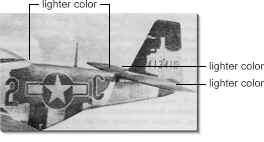 patch of brighter color on the fuselage between the rear end of canopy and the ”C”? You can? Now, compare this to our color photograph. Does the patch appear in the same place? It does! So, here we have it – a rear fuselage spine was painted a lighter color.
patch of brighter color on the fuselage between the rear end of canopy and the ”C”? You can? Now, compare this to our color photograph. Does the patch appear in the same place? It does! So, here we have it – a rear fuselage spine was painted a lighter color.
Moreover, I would say that the photo displays further patches of light color on both horizontal tail surfaces. This is illustrated by the inset photo to the left.
On the other side, the port wing appears to be in solid dark color, but the definitive judgement of this is difficult because of the sharp angle of view.
So, how am I going to paint my model of LOU IV? Just as I described above, I suppose…. Natural metal lower surfaces and dark green upper surfaces with extra three irregular blotches of blue paint – one large covering the fuselage spine and two on the right and left horizontal tail, respectively.
Considering lack of further evidence on the wings’ upper color, I’d choose to go after what we’ve seen so far and use green overall. Perhaps somebody else comes up another time with the photo to confirm/deny this.
Now, the final question: what colors will I use? Olive Drab and British Roundel Blue seems like a perfectly proper answer to me. But, since I like extraordinary paint schemes, I’d rather go further and choose British Dark Green and Roundel Blue for my model, according to Ron’s hypothesis.
Am I going to build it? You bet, after this fascinating discussion…
Epilogue
(Ed: After publishing this article for the first time, Dana Bell responded in a way that makes a fine epilogue to this story)
Dana Bell:
Martin,
I’m glad you found the rec.models.scale posting I wrote last weekend; your posting on the IPMS Stockholm page was great – a good way to assemble all of the points of view! It also reminded me that I owed you a reply.
I don’t have anything to add – I suspect you’ve already seen the pieces several of us ran in the IPMS USA Journal several years back (I haven’t – Martin). It seems pretty clear that the two colors on LOU IV resulted from the Invasion Stripes and the horizontal tail ID stripes. Note how in the b&w image you posted the lighter shade on the near wing and on the fuselage correspond exactly with the position of the full Invasion Stripes. And the lighter section of the stabilizer is where the black ID stripe was. This gives us several possibilities:
- The Invasion Stripes were overpainted with one color; later, a second, darker color was applied to other areas.
- One color was used overall, and that color has a different appearance when sprayed over existing paint or natural metal. (Specular reflectance could cause this, or the existing paint could act as a primer?)
- Similar to 2, but additional coats were needed to cover the Invasion Stripes.
- Similar to 2, but the Invasion Stripes are bleeding through an changing the appearance of the top coat.
Keep up the good work, and enjoy the model!
Dana
More reading
More comments about the LOU IV and it’s colors can be found in the follow-up article Seeing is Believing: LOU IV Addendum.
This article was originally published in IPMS Stockholm Magazine in May 1998.
